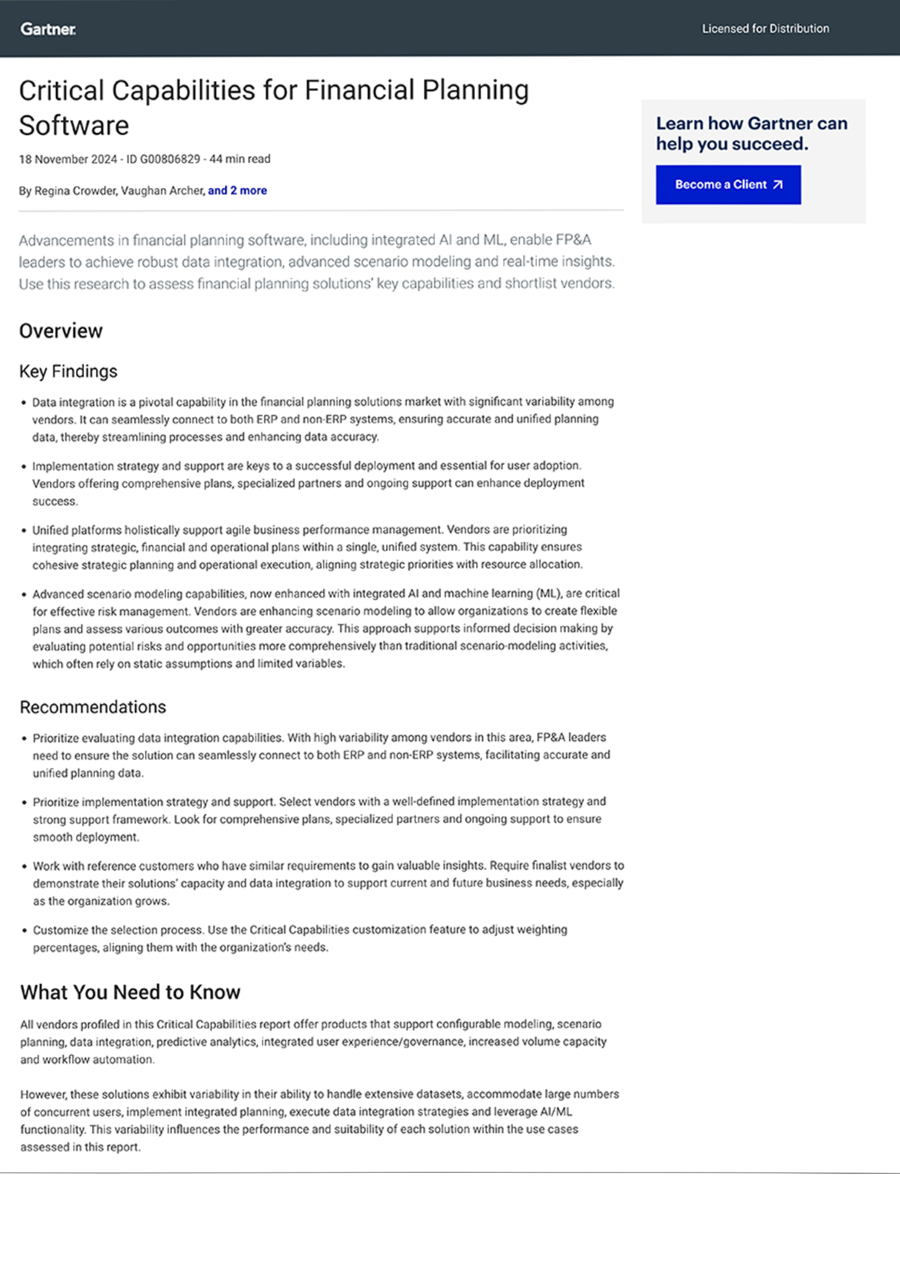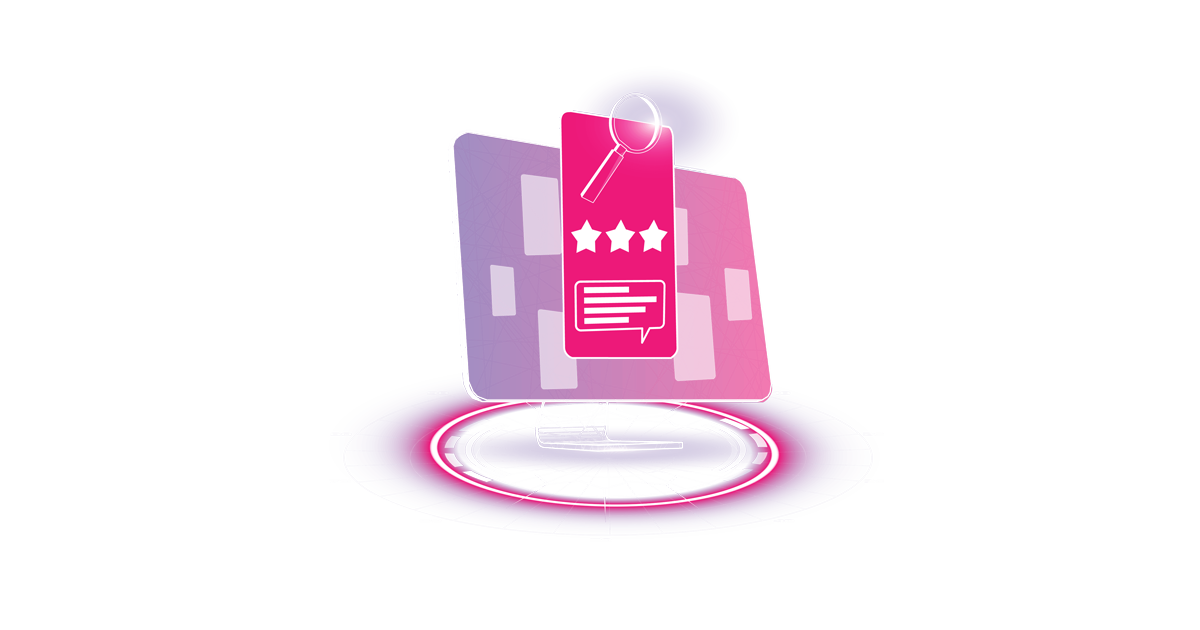
Unlock precision and control with activity-based budgeting
- Activity-based budgeting vs. traditional budgeting
- Activity-based budgeting vs. zero-based budgeting
- The pros of activity-based budgeting
- Overcoming the challenges of activity-based budgeting
- How to implement activity-based budgeting
- Activity-based budgeting in action
- Streamline any financial budgeting process with FP&A software
- Embrace precision and efficiency with activity-based budgeting
Budgeting is a crucial part of any business. It aids planning, cost control, and resource allocation. Yet, traditional budgeting methods often fall short, struggling to keep pace with the dynamic nature of modern organizations—especially in today’s uncertain economy.
Enter activity-based budgeting (ABB). Unlike traditional methods that rely heavily on historical data—which, for many organizations, has become unreliable in recent years—ABB focuses on the real costs of business activities. This approach improves accuracy and transparency in resource allocation, offering more control over the budget and helping to reduce costs where it matters most.
In this blog post, we’ll delve into the benefits of ABB to explore how it can enhance decision-making, boost performance, and streamline operations. Whether you’re a financial professional, business owner, or part of a management team, read on to take a deeper dive into activity-based budgeting.
What is activity-based budgeting?
Activity-based budgeting is a method focused on the costs incurred by specific business activities. Instead of assigning costs to departments, it allocates them to activities that use up resources.
This approach gives a more precise view of where money is spent and why, providing insights into cost drivers and helping identify areas that can be optimized. Activity-based budgeting helps organizations focus on necessary activities that align with their objectives.
Activity-based budgeting vs. traditional budgeting
Primarily, ABB and traditional budgeting differ in their approach to allocating funds. Traditional budgeting relies on past spending patterns, adjusting amounts incrementally without focusing on individual activities. ABB, however, assigns resources based on the costs of specific business activities—offering more detailed insights into where money is spent.
ABB’s focus on activities gives organizations a more nuanced understanding of cost drivers, encouraging efficiency and cost-cutting where necessary. For organizations seeking more precise cost control, ABB is a solid choice.
In contrast, traditional budgeting can be less flexible, as it doesn’t analyze expenses per activity and may lead to missed opportunities to save on costs. However, traditional budgeting is easier to implement and fits stable spending patterns.
Here’s a few ways the two approaches differ:
- Adaptability: ABB adjusts to real-time needs, while traditional budgeting may limit planning by following previous budgets
- Cost allocation: ABB focuses on the cost of specific activities, while traditional budgeting uses past spending patterns
- Simplification: ABB clarifies specific cost drivers and simplifies complex budgeting processes, while traditional budgeting may overlook these finer details
Both activity-based and traditional budgeting offer unique advantages depending on your organization’s goals and operational needs. Choosing the right method depends on your business’s needs. So, consider if you value detailed activity tracking or prefer a simpler, historical approach to budgeting.
Activity-based budgeting vs. zero-based budgeting
In contrast to ABB, zero-based budgeting (ZBB) starts each budgeting cycle from a “zero base,” where all expenses must be justified. This method promotes careful thinking about costs. It asks departments to explain each expense, no matter what past budgets showed.
The main difference between ABB and ZBB is in how they handle resource allocation. ABB looks at what activities drive costs and funds those activities accordingly to promote efficiency. ZBB, however, focuses on essential expenses, starting from zero and making departments justify each cost. While ABB is more activity-oriented, ZBB is more focused on necessity—asking whether each expense is essential to achieving the organization’s goals.
Both budgeting methods offer unique benefits but come with specific challenges. ABB provides clear insight into operational costs and can help streamline processes by cutting non-essential activities. However, it may not address overall expenditure patterns as thoroughly as ZBB.
Meanwhile, ZBB’s rigorous process can lead to significant cost savings by enabling analytical replanning and eliminating outdated or unjustified expenses. Yet, ZBB can be resource-intensive and can also lead to a narrower focus, favoring short-term planning over long-term strategic goals.
The pros of activity-based budgeting
ABB offers numerous advantages over other budgeting methods. With a clearer understanding of where resources should go, it allows for more informed financial decisions and efficient operations.
Overall, ABB can increase an organization’s ability to adapt to market changes with more detailed insights. With ABB, organizations benefit from:
1. Improved resource allocation
One of the main advantages of ABB is improved resource allocation. This approach allows businesses to allocate funds based on actual data, leading to better financial health and efficiency.
2. Enhanced budget control
ABB enhances budget control by providing detailed cost information. This transparency helps organizations monitor expenses closely to reduce waste and manage budgets more effectively.
3. Better performance budgeting
Performance budgeting gets a boost from the activity-based approach. By understanding cost drivers, businesses can match budgets with performance goals. This leads to better efficiency and a clearer path to success.
4. Strategic alignment and decision-making
Strategic alignment is a key benefit of ABB. This method ensures resources are in line with organizational goals, which aids in quicker, more confident decision-making processes.
Overcoming the challenges of activity-based budgeting
Implementing ABB can present challenges, and transitioning from traditional methods requires strategic planning and commitment. This approach demands more detailed data collection, which can initially be time-consuming.
To overcome these challenges, organizations should:
- Invest in training and education for staff: Training ensures that employees understand ABB principles. This knowledge allows them to allocate resources correctly and helps them make informed budgeting decisions based on activity-based methods.
- Utilize technology to streamline processes: Using financial planning & analysis (FP&A) software simplifies the tracking and analysis involved in ABB, reducing manual work and improving accuracy and efficiency.
- Foster a culture that embraces change: Encouraging a culture of continuous improvement helps lessen resistance to ABB by involving employees in the transition and highlighting its long-term benefits.
By addressing these challenges proactively, organizations can make ABB an effective tool.
How to implement activity-based budgeting
When switching to ABB, it’s important that organizations follow a structured approach to ensure accurate and efficient implementation.
Below, we’ll cover a step-by-step process of setting up ABB effectively with the help of a digital twin, which is a virtual model of the business that captures key financial and nonfinancial metrics—representing relationships, structures, and processes across the organization.
1. Identify key business activities
The first step is to outline the core activities driving costs in your organization. This involves analyzing every operational task, from production to administrative functions, to see where resources are being spent. Clearly identifying these activities provides the foundation for assigning costs and helps you understand which processes are most critical.
2. Determine cost drivers
Once you have a list of activities, you can use a digital twin to identify the specific cost drivers for each one. For example, in manufacturing, the digital twin can simulate how unit volume or machine hours affect costs, allowing precise tracking of cost influencers. This data enables you to allocate resources based on actual demand and refined analysis, instead of broad assumptions.
3. Gather and analyze your data
Collect detailed data on costs and resource use for each activity, including labor, materials, and utilities. A digital twin then provides an ongoing simulation of these activities, offering real-time insights and more accurate projections. By analyzing this digital model, you gain a realistic baseline for activity costs, creating a clear picture of resource distribution within the organization.
4. Allocate costs to activities
With data in hand, assign costs to each activity using the data gathered and analyzed through the digital twin. This step is crucial for linking actual expenses to specific tasks, ensuring the budget reflects true operational costs. It also highlights areas needing more or fewer resources, allowing for more precise resource planning.
5. Set budget goals based on activity levels
Using the information from your cost analysis, set budget goals for each activity. With your digital twin, you can model future scenarios, such as changes in demand. This allows you to scale resources and expenses up or down according to anticipated activity levels.
6. Monitor and adjust regularly
Implementing ABB is an ongoing process, and a digital twin helps track and adjust costs as operations evolve. By monitoring activities through this model, you can make real-time budget adjustments to ensure funds align with current needs and priorities, enhancing flexibility and accuracy in budgeting.
Activity-based budgeting in action
Let’s consider an example: Company A is an electronic manufacturing busines s forecasting production of 50,000 circuit boards next year. Each circuit board requires assembly, testing, and quality inspection, costing $4 per unit to complete these specific activities. So, Company A’s activity-based approach estimates a budget of $200,000 (50,000 units * $4) for production-related activities.
In contrast, if Company A used traditional budgeting, it would rely only on last year’s inspection costs and incremental growth. Assuming last year’s production costs were $150,000 and expecting a 15% year-on-year (YoY) increase, they’d only allocate $172,500—likely underestimating actual requirements and risking production delays.
With ABB, Company A’s budget directly aligns with anticipated production levels, giving a clearer and more accurate forecast for costs associated with assembly and inspection. Traditional budgeting, which depends on historical data and YoY incremental increases, may underestimate true operational demands and create resource gaps.
Streamline any financial budgeting process with FP&A software
With FP&A software , organizations can streamline budgeting by centralizing data across departments, creating a single source of truth (SSOT) that reduces manual data entry and errors.
This consolidation frees Finance teams to focus on analysis instead of time-consuming data gathering, accelerating the budgeting and forecasting process. By integrating real-time data, FP&A tools provide accurate, up-to-date insights.
In turn, this enhances decision-making and supports a more efficient, nuanced planning workflow.
Simplification, integration, and adaptability: How the Jedox platform supports activity-based budgeting
With features for planning, forecasting, and scenario analysis, adaptable FP&A platforms like Jedox help organizations quickly adjust budgets to meet changing needs. This allows Finance teams to streamline budgeting for different departments while maintaining a cohesive, holistic business view.
At the same time, Jedox’s customizable templates, called Best Practice Accelerators (BPAs), also enable other teams—like Sales and Operations—to concentrate on their specific budgeting tasks. From revenue forecasting for Sales to supply chain planning for Operations, non-Finance teams can plan without needing to navigate the entire financial model.
And because each department works within templates that feed into a unified financial model, Jedox gives Finance leaders a complete, integrated view of the business—combining targets and plans from every team to align resources effectively and respond quickly to market changes.
Ultimately, the Jedox platform enables a culture of decisiveness, confidence and performance—enhancing the activity-based budgeting process via:
Simplification: Making complex tasks easy
- Jedox’s Excel-like interface supports easy adoption, fostering better collaboration across all teams and departments
- Automated workflows allow even non-technical stakeholders to contribute, accelerating the entire ABB process
- Quickly and easily produce a shareable summary of your ABB plans to enhance alignment across teams using JedoxAI, one of the platform’s generative AI features
Integration: Eliminate data silos with an accessible, unified SSOT
- Automate the integration of data from any internal or external source to create a comprehensive SSOT. This enables all stakeholders to work with data flows that are time-controlled, consistent, and accurate
- Create a digital twin of your organization to see an ongoing simulation of your activities, as well as track and adjust costs as your operations evolve
- Amplify insights and boost collaboration with financial and non-financial data —think workforce planning data from HR or logistics data from Operations—to successfully implement a dynamic ABB plan that cover the entire organization’s performance
Adaptability: Scale performance as your business grows
- Drive value and flawlessly adapt to changing business requirements—enhancing your ABB process—with the world’s most adaptable planning and performance management platform
- Use Jedox AIssisted™ Planning to uncover actionable insights, create Time Series Predictions, perform Driver Analysis, and more. This allows you to more effectively future proof your business and drive the digital transformation of finance
In short, Jedox makes activity-based budgeting accessible and efficient, improving your data quality, resource allocation, and financial performance across the board.
Embrace precision and efficiency with activity-based budgeting
The future of ABB looks promising as businesses around the world seek adaptive financial strategies. While it requires upfront effort, its benefits—enhanced efficiency, transparency, and flexibility—can significantly improve financial planning. Plus, its integration with FP&A technology offers countless opportunities for innovation.
Using an enterprise performance management (EPM) tool like Jedox makes implementing ABB simple and effective. This, in turn, helps improve decision-making and keeps organizations competitive in a changing market. To see how Jedox can streamline your budgeting and forecasting processes, request a demo today.






